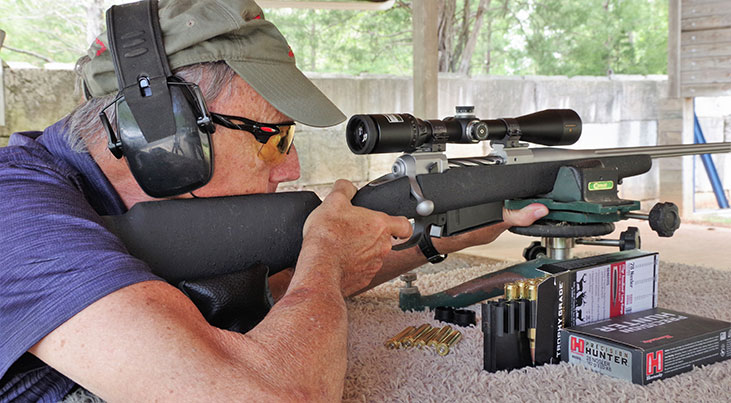By Jon R. Sundra
I have been a fan of the 7mm bore all my life, even before I quit an honest job to become a gun writer. It started in 1962 when Remington introduced its 7mm Magnum. I guess it was just my natural contrariness that I had little interest in the .270 or .30-06. I was in school at the time, so my hunting days were still ahead, but I was leaning toward building a .280 Rem. Of course, the 7 Mag changed all that. Since then, literally hundreds of 7mm rifles have passed through my hands as test and personal guns in every commercial caliber from 7×57 to Remington’s Ultra Mag, as well as several wildcats, including my own 7mm JRS.

The only sure thing is that things change. As new cartridge cases and new powders are introduced, the options change, so that what I thought was the perfect 7mm one year, no longer was. Not only that, one’s criteria also changes. Where once I thought velocity was everything, other considerations such as the trade-offs in muzzle blast, recoil, accuracy, barrel life and just plain cartridge efficiency entered the picture. At different times I thought the perfect cartridge for me was the 7 Rem. Mag, .284 Win., my 7mm JRS, 7mm Dakota, and 7mm WSM. I’m sure that virtually everyone reading these words has gone through similar epiphanies regarding cartridges as well as rifles.
One of the many things I’ve always liked about the 7mm was the choice of bullet weights. As a caliber, it continues to grow in popularity to where today a handloader has 23 options: 100, 110, 115, 120, 125, 130, 139, 140, 145, 150, 154, 155, 160, 162, 166,168, 170, 175, 180, 184,185, 190 and 195 grains. That’ more than the .270 and .308 combined. And most of them are offered in one or more factory loadings.

The one round I now find most intriguing is the 28 Nosler. It is touted as being the most potent 7mm that will fit into a standard .30-06-length action (3.340 inch COL), and indeed it is. There was a time when I would not have considered a 7mm based on a case that held some 12-percent more powder than the 7 Rem Magnum — too inefficient.
But like I said, things change. With modern, ultra slow-burning powders like Retumbo, Norma 217, RL25 and IMR 8133 to name some, if the 28 Nosler is “overbore capacity,” it’s just marginally so. Backing up that statement is the fact that the Nosler Reloading Guide lists six loads that yield muzzle velocities between 3,269 and 3,293 fps with a 160-grain bullet.
And the Hornady manual shows four loads producing 3,300 with a 162-grain bullet. Now granted, those numbers were achieved with 26-inch barrels. I won’t carry a 26-inch barreled rifle but subtracting even 100 fps for a 2-inch shorter barrel you’re still looking at 3,200 fps for 160- and 162-grain bullets!
I hasten to point out that the Hornady manual shows only one handload for the huge 7mm Rem. Ultra Mag achieving 3,300 fps with a 162-grain bullet, while the Nosler source shows 3,258 as the top handload for their 160-grain. That’s what I mean about overbore capacity and cartridge efficiency. With a 13 percent smaller case, the 28 Nosler equals or beats the Ultra Mag.

After ruminating over these stats, I went ahead and ordered a 28 Nosler from Shaw Custom Rifles in Bridgeville, Pennsylvania. I ordered their Mark X model, which is based on a Shaw-designed hybrid Savage 110. It differs in that the receiver has an integral Picatinny rail and recoil lug, and under a licensing agreement with Savage, employs the AccuTrigger fire control system. I ordered it in stainless, with a 24-inch straight-fluted barrel in an H-S Precision stock.
I plan to have the throat (leade) extended so I can seat the heavier-weight bullets out to where they’re not infringing on usable powder space. I’ve been doing that with all my personal rifles going back to the initial development of my 7mm JRS back in the mid-’70s. In other words, by using actions longer than what factory ammo is dimensioned to, I effectively increase the size of the cartridge case and its ballistic potential.
The Shaw, Savage, Sako, Remington and Winchester long actions are actually magnum-length and will accept cartridges of 3.6 inches. That’s what makes my 7mm JRS a better cartridge than the .280 Ackley Improved. I can seat bullets out where they belong, something the industry has finally discovered with the 6mm and 6.5 Creedmoor, 6.5mm and .300 PRC. I fully expect to get 3,300 fps from my 24-inch barreled, long-throated 28 Nosler.
In the meantime, however, I mounted a Nikon Monarch 3 4-16×42 scope (alas, Nikon scopes are no more), and went to the range with Hornady’s 162-grain ELD-X and Nosler’s 175-grain ABLR, both of which are loaded to 3.340-inch COL. Three-shot groups with the Hornady load ranged from .85 inch to 1.35 inches, which for a super magnum with a barrel that’s not yet broken in, damn good.

The Nosler load did not do as well, but I suspect it was because the 175-grain bullet was just marginally stabilized in the Mark X’s 1-9.5-inch twist barrel. A 1-8 twist is required to stabilize the heaviest 7mm match bullets, but this is strictly a hunting rifle, and I don’t plan on using any bullets heavier than 162 grains.
Shaw’s Mark X is a semi-custom rifle at a nearly production rifle price. Mine was $1,920, but if ordered in blued chrome moly with a non-fluted barrel and bolt and in a laminated stock, it would have been considerably less. shawcustombarrels.com.

